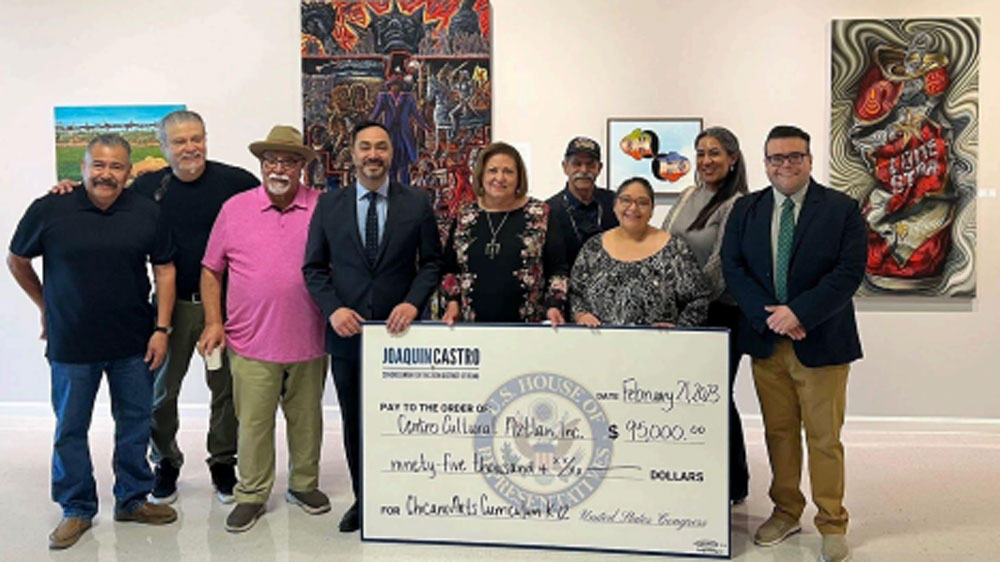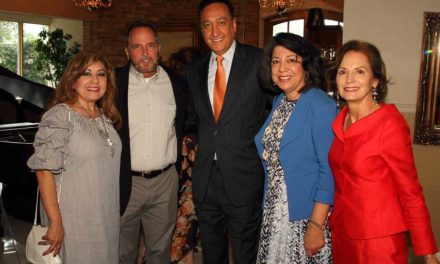San Antonio’s Latino Westside community is abuzz with music, art, and literacy activities. The Conjunto Festival sponsored by the Guadalupe Cultural Center saw record crowds on May 16, 2024; its bookstore across the street from the famed Guadalupe Theater drew readers and art lovers to its premier Latino Bookstore Education Outreach and Literacy Program.
On the city’s northwest sector, Centro Cultural Aztlan hosted a joyous Latino art evening event demonstrating that the creative work of Latino artists has a firm place in the hearts and minds of young students. The Centro showcased the newly developed art curriculum program funded by the U.S. Department of Education.
Thanks to Texas Congressman Joaquin Castro’s work to secure funding for the arts and education on San Antonio’s Westside, more than $200,000 in federal funding was put to good use over the past 24 months at the Guadalupe Book Store and Centro Cultural Aztlan. Congressman Castro took to heart the National Endowment of the Arts mantra that the “Arts belong to all the people of the United States.” This represents a significant change over previous decades when Latinos received few federal grants because many artists and Latino organizations did not have the grant-writing expertise or teams to compete adequately.
The Centro Cultural Aztlan was founded in the late 1970s to enhance art access to San Antonio’s Latino community. During this decade, many San Antonio Latino residents struggled daily to survive financially allowing little time to devote an interest in the arts. When the Centro opened its art complex in the city’s Westside, the area was one of the poorest urban communities in the nation.
According to the 1970 U.S. Census data cited in the social science book The Mexican American People by authors Leo Grebler, Joan Moore, and Ralph Guzman, 74 percent of San Antonio Latinos earned less than $5,000 annually. The U.S. Census data cited in this study also confirmed low educational attainment: only nine percent of Latinos in San Antonio
had completed high school in 1970. Even fewer Latinos had earned college degrees. The data show only two percent of the city’s Latino population had completed more than four years of college.
Joaquin Castro grew up in San Antonio’s Westside, an area he now represents as the U.S. Congressman for District 20. The community remains poor. Part of this congressional district is adjacent to zip code 78207, the lowest-income area in the city. The educational level in the Westside has improved over the past 50 years, especially in high school completion which the 2020 U.S Census counted at 45.1 percent. However, college completion among Westside residents demonstrates a great educational gap compared to the rest of the city. The 2020 U.S. Census also reported that only 2.7 percent of residents of this Westside district had completed a Bachelor’s degree.
On May 16, the Centro Cultural Aztlan opened an art exhibit representing student artwork from six school districts in the city. Artists/Educators Luis Valderas and Kim Bishop organized the exhibit as part of a larger art education project submitted to the Department of Education by Centro Director Malena Gonzalez-Cid and supported by Congressman Joaquin Castro. The Centro received a grant from the Department of Education for $95,000 in 2023 and completed the proposed art projects in Spring 2024.
The Centro project produced an arts education curriculum consisting of 40 lesson plans, including lessons created for Primary (PreK-2nd), Intermediate (3rd-5th), Middle School (7th-8th), and Secondary (9th-12th) students. Nine teachers implemented the curriculum with at least 600 students in Year 1 from Northside ISD, Northeast ISD, Incarnate Word HS, San Antonio ISD, Edgewood ISD, and Harlandale ISD. This curriculum will be shared with additional arts educators in the summer of 2024 in professional development workshops and open-source documents.
Scarlet Fuentes,
The project managers, Bishop and Valderas, LLC., brought together a team of artists, educators, historians, and cultural experts to develop lesson plans with audiovisual resources and age-appropriate art activities to engage K-12 students in learning about Chicano art, culture, and history. Bishop and Valderas conceived the idea of preserving the legacy of local Latino artists and developed the template for the art curriculum.
The project managers organized a team of award-winning artists/educators representing six San Antonio school districts and one university to write and present these art lessons. Participating students created art inspired by selecting an artist from a list of more than fifty established Latino artists. The students researched the artists’ backgrounds and artwork and produced artwork in a style similar to that of the chosen artist. The teachers selected representative art for the Centro exhibit.
The Centro is an art beacon for the 60,000 residents in the San Antonio City Council Districts One, Five, and Seven that the organization principally serves. Larger cultural and exhibit events, which include Day of the Dead, Guadalupana celebrations, and Segundo de Febrero attract thousands of visitors from the entire city and beyond. These special events complement the Centro’s “Platica” interview series hosted every Friday evening. The interviews are carried on the Centro’s special YouTube channel.
The Centro is one of the leading art centers in Texas recognized and funded by major organizations such as the National Endowment for the Arts, Texas Commission of the Arts, the San Antonio Area Foundation, Alice Kleberg Reynolds Foundation, and more recently, the U.S. Department of Education. In the past decade, the Centro has provided exhibit space for nearly five hundred artists annually. Under the direction of Malena Gonzalez-Cid, the Centro’s future is bright as the
non-profit readies new gallery spaces and begins preparing the celebration of its 50th year in operation in 2028.
Nine teachers implemented the curriculum with at least 600 students in Year 1. They include the following Kim Bishop MA.,
MFA.—UTSA-PaCE, Mandy Clarson—NISD, Hector Garza PhD.—Incarnate Word HS, Noe Garza—Harlandale ISD, Brandy González MFA.—NISD, Clayton Kilduff—NISD, Elizabeth San Miguel—Edgewood ISD, Clifton Tinker—NEISD, Kimberly Villarreal—NEISD and Monico Vitela—SAISD.
U.S. Department of Education Funds San Antonio Latino Arts










